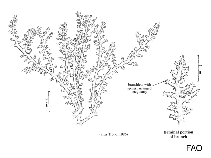Digenea simplex (Wulfen) C. Agardh
Red seabroom| Native range | All suitable habitat | Point map | Year 2050 |

|
| This map was computer-generated and has not yet been reviewed. |
| Digenea simplex AquaMaps Data sources: GBIF OBIS |
Upload your photos
Google image | No image available for this species;
drawing shows typical species in Rhodomelaceae.
Google image | No image available for this species;
drawing shows typical species in Rhodomelaceae.
Classification / Names Common names | Synonyms | CoL | ITIS | WoRMS
Florideophyceae | Ceramiales | Rhodomelaceae
Environment: milieu / climate zone / depth range / distribution range Ecology
Sessile; depth range 0 - 20 m (Ref. 80758). Tropical
Distribution Countries | FAO areas | Ecosystems | Occurrences | Introductions
Indo-Pacific and Atlantic Ocean.
Length at first maturity / Size / Weight / Age
Maturity: Lm ? range ? - ? cm
Short description Morphology
Thalli erect, dull brownish red. Branches densely clothed with hair-like determinate branchlets, especially at the upper half portion of the thallus. Branching of the main axis basically dichotomous but may become irregular due to the production of adventitious laterals. Determinate branchlets uncorticated and consisting of a distinct axial cell surrounded by nine pericentral cells. Thalli up to 9 cm in height (Ref. 80758).
Utilized for medicinal purposes: as anthelmintic, vermifuge and laxative; source of agar, kainic and a-allokainic acids, kainic acid is a vermifuge or anthelmintic against the parasitic round worm (Ascaris), the whip worm (Trichuris), and tapeworm (Taenia) (Ref. 80758).
Life cycle and mating behavior Maturity | Reproduction | Spawning | Eggs | Fecundity | Larvae
Main reference
References | Coordinator | Collaborators
Guiry, M.D. and G.M. Guiry. 2009. (Ref. 80701)
IUCN Red List Status (Ref. 130435: Version 2024-1)
CITES status (Ref. 108899)
Not Evaluated
CMS (Ref. 116361)
Not Evaluated
Threat to humans
Harmless (Ref. 80758)
Human uses
Fisheries: commercial
FAO - Fisheries: landings | FishSource | Sea Around Us
Tools
More information
Trophic Ecology
Food items
Diet
Food consumption
Ration
Predators
Diet
Food consumption
Ration
Predators
Ecology
Population dynamics
Growth
Age/Size
Length-weight
Length-length
Length-frequencies
Mass conversion
Recruitment
Abundance
Age/Size
Length-weight
Length-length
Length-frequencies
Mass conversion
Recruitment
Abundance
Life cycle
Reproduction
Maturity
Fecundity
Spawning
Eggs
Egg development
Larvae
Larval dynamics
Maturity
Fecundity
Spawning
Eggs
Egg development
Larvae
Larval dynamics
Distribution
Human Related
Aquaculture profile
Stamps, Coins Misc.
Stamps, Coins Misc.
Outreach
References
Internet sources
BHL | BOLD Systems | CISTI | DiscoverLife | FAO(Fisheries: ; publication : search) | Fishipedia | GenBank (genome, nucleotide) | GloBI | Gomexsi | Google Books | Google Scholar | Google | PubMed | AlgaeBase | Tree of Life | Wikipedia (Go, Search) | Zoological Record
Estimates based on models
Preferred temperature
(Ref. 115969): 18.1 - 28.9, mean 26.9 (based on 4020 cells).



